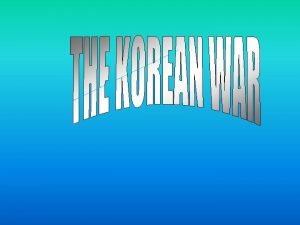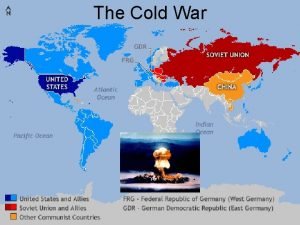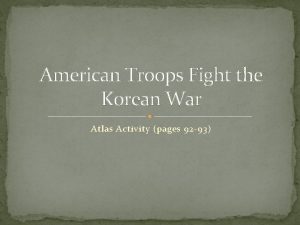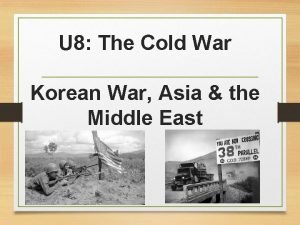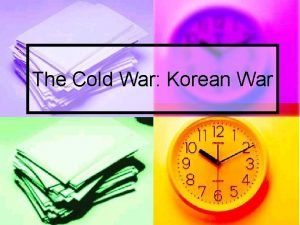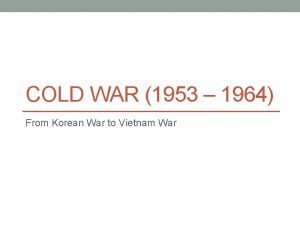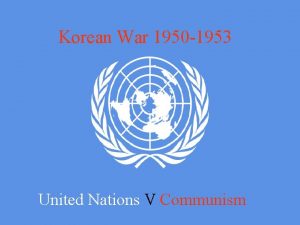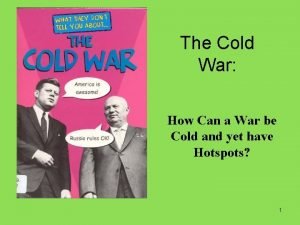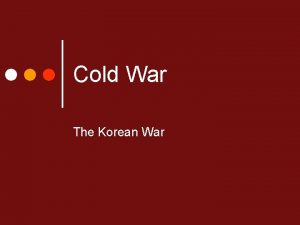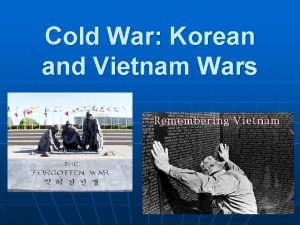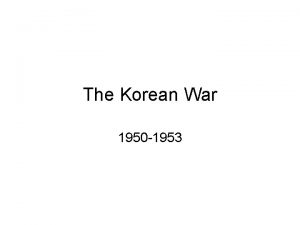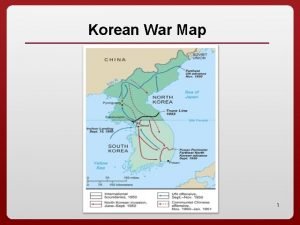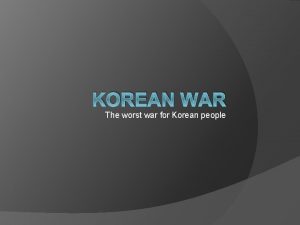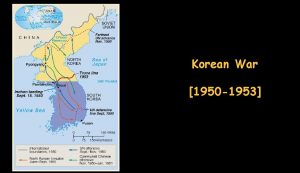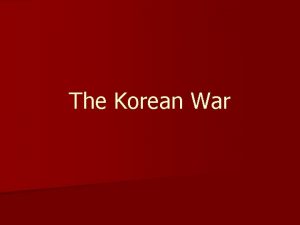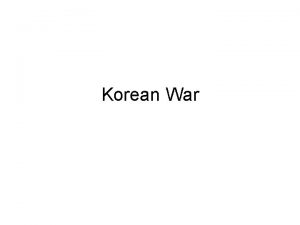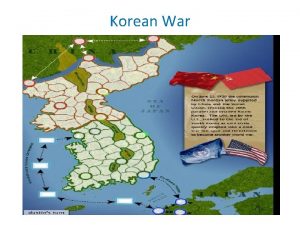THE KOREAN WAR AN OVERVIEW The Korean War













- Slides: 13

THE KOREAN WAR

AN OVERVIEW The Korean War, 1950– 1953 � The Korean War began as a civil war between North and South Korea, but the conflict soon became international when, under U. S. leadership, the United Nations joined to support South Korea and the People’s Republic of China (PRC) entered to aid North Korea. The war left Korea divided and brought the Cold War to Asia. � http: //www. military. com/video/operations-and- strategy/korean-war-begins/658181834001/

THE TWO KOREAS Since the beginning of the 20 th century, Korea had been a part of the Japanese empire, and after World War II it fell to the Americans and the Soviets to decide what should be done with their enemy’s imperial possessions. In August 1945, two young aides at the State Department divided the Korean peninsula in half along the 38 th parallel. The Russians occupied the area north of the line and the United States occupied the area to its south. By the end of the decade, two new states had formed on the peninsula. In the south, the anti-communist dictator Syngman Rhee enjoyed the reluctant support of the American government; in the north, the communist dictator Kim Il Sung enjoyed the slightly more enthusiastic support of the Soviets. Neither dictator was content to remain on his side of the 38 th parallel, however, and border skirmishes were common. Nearly 10, 000 North and South Korean soldiers were killed in battle before the war even began.

THE START On June 25, 1950, the Korean War began when some 75, 000 soldiers from the North Korean People’s Army poured across the 38 th parallel, the boundary between the Soviet-backed Democratic People’s Republic of Korea to the north and the pro. Western Republic of Korea to the south. � This War. invasion was the first military action of the Cold

AMERICA JOINS THE WAR By July, American troops had entered the war on South Korea’s behalf. As far as American officials were concerned, it was a war against the forces of international communism itself. “If we let Korea down, ” President Harry Truman said, “the Soviet[s] will keep right on going and swallow up one [place] after another. ” http: //www. military. com/video/operations-andstrategy/korean-war-starts 1950/2303035467001/

WARTIME PROPAGANDA US - http: //www. military. com/video/operations-andstrategy/korean-war/the-crime-of-korea 1950/2849440130001/ Chinese - http: //www. military. com/video/operationsand-strategy/korean-war/chinese-propaganda-piece -1952/2670951746001/

BODO LEAGUE MASSACRE The Bodo League massacre was a massacre and war crime against communists and suspected sympathizers that occurred in the summer of 1950 during the Korean War. Estimates of the death toll vary. According to Prof. Kim Dong-Choon, Commissioner of the Truth and Reconciliation Commission, at least 100, 000 people were executed on suspicion of supporting communism; others estimate 200, 000 deaths. The massacre was wrongly blamed on the communists for decades. � Included in these strings of massacres was the Taejon Massacres � At Taejon, about 140 kilometres south of Seoul, prisoners were shuttled out of the city's jail by the army and police, marched with hands bound to the edge of long trenches, made to lie down, and then shot with rifles. Their bodies were rolled in and covered. The death shuttle went on for days, as the North Koreans advanced, with up to 7000 prisoners executed, according to the commission.

BATTLE STRATEGIES At first, the war was a defensive one–a war to get the communists out of South Korea–and it went badly for the Allies. The North Korean army was well-disciplined, well-trained and well -equipped � South Korean forces, by contrast, were frightened, confused, and seemed inclined to flee the battlefield at any provocation. � Also, it was one of the hottest and driest summers on record, and desperately thirsty American soldiers were often forced to drink water from rice paddies that had been fertilized with human waste. As a result, dangerous intestinal diseases and other illnesses were a constant threat. � By the end of the summer, President Truman and General Douglas Mac. Arthur, the commander in charge of the Asian theater, had decided on a new set of war aims. Now, for the Allies, the Korean War was an offensive one: It was a war to “liberate” the North from the communists. � http: //www. military. com/video/operations-and-strategy/koreanwar/korean-war-gun-cam-footage/2096492639001/ �

WORLD WAR III? Initially, this new strategy was a success. An amphibious assault at Inchon pushed the North Koreans out of Seoul and back to their side of the 38 th parallel. But as American troops crossed the boundary and headed north toward the Yalu River, the border between North Korea and Communist China, the Chinese started to worry about protecting themselves from what they called “armed aggression against Chinese territory. ” Chinese leader Mao Zedong sent troops to North Korea and warned the United States to keep away from the Yalu boundary unless it wanted full-scale war This was something that President Truman and his advisers decidedly did not want: They were sure that such a war would lead to Soviet aggression in Europe, the deployment of atomic weapons and millions of senseless deaths. To General Mac. Arthur, however, anything short of this wider war represented “appeasement, ” an unacceptable knuckling under to the communists.

“NO SUBSTITUTE FOR VICTORY” As President Truman looked for a way to prevent war with the Chinese, Mac. Arthur did all he could to provoke it. Finally, in March 1951, he sent a letter to Joseph Martin, a House Republican leader who shared Mac. Arthur’s support for declaring all-out war on China–and who could be counted upon to leak the letter to the press. “There is, ” Mac. Arthur wrote, “no substitute for victory” against international communism. For Truman, this letter was the last straw. On April 11, the president fired the general for insubordination.

THE END OF THE WAR In July 1951, President Truman and his new military commanders started peace talks at Panmunjom. Still, the fighting continued along the 38 th parallel as negotiations stalled. Both sides were willing to accept a ceasefire that maintained the 38 th parallel boundary, but they could not agree on whether prisoners of war should be forcibly “repatriated. ” (The Chinese and the North Koreans said yes; the United States said no. ) Finally, after more than two years of negotiations, the adversaries signed an armistice on July 27, 1953. The agreement allowed the POWs to stay where they liked; drew a new boundary near the 38 th parallel that gave South Korea an extra 1, 500 square miles of territory; and created a 2 -mile-wide “demilitarized zone” that still exists today.

CAUSALITIES OF THE WAR The Korean War was relatively short but exceptionally bloody. Nearly 5 million people died. More than half of these–about 10 percent of Korea’s prewar population–were civilians. (This rate of civilian casualties was higher than World War II’s and Vietnam’s. ) Almost 40, 000 Americans died in action in Korea, and more than 100, 000 were wounded.

SOURCE • • • • Article Details: Korean War Author History. com Staff Website Name History. com Year Published 2009 Title Korean War URL http: //www. history. com/topics/korean-war Access Date April 07, 2014 Publisher A+E Networks
 Presidential and radical reconstruction venn diagram
Presidential and radical reconstruction venn diagram Description
Description The causes of the korean war
The causes of the korean war Cause of korean war
Cause of korean war Korean war map activity answers
Korean war map activity answers American troops fight the korean war 48a answer key
American troops fight the korean war 48a answer key Korean war webquest
Korean war webquest Rollback cold war
Rollback cold war Finnish korean war
Finnish korean war The korean war
The korean war What were the causes of the korean war
What were the causes of the korean war Korean war
Korean war Causes of korean war
Causes of korean war Cause of korean war
Cause of korean war


